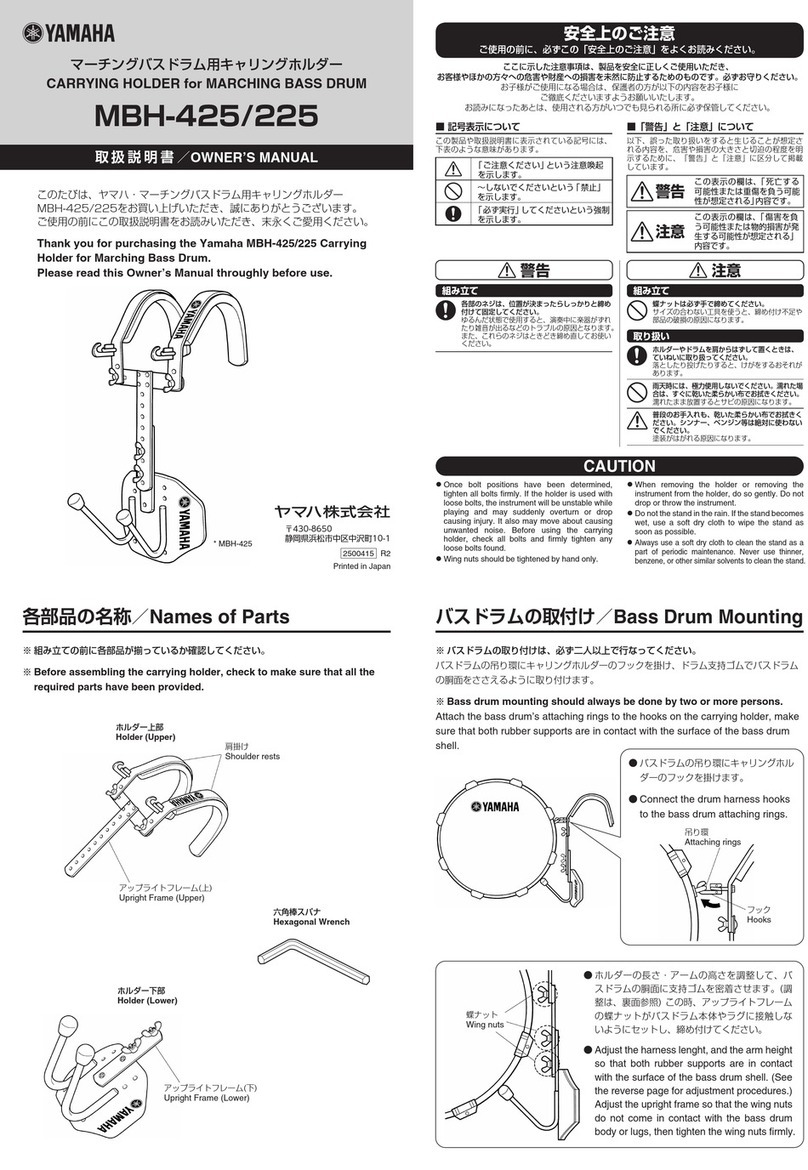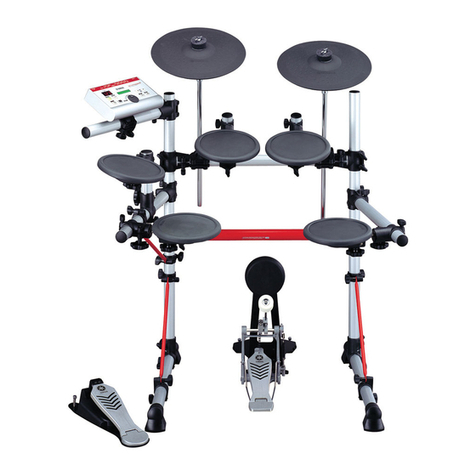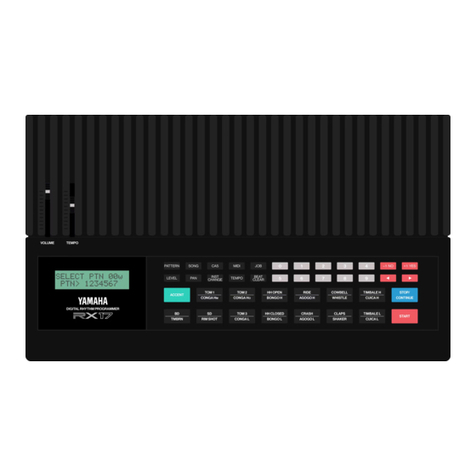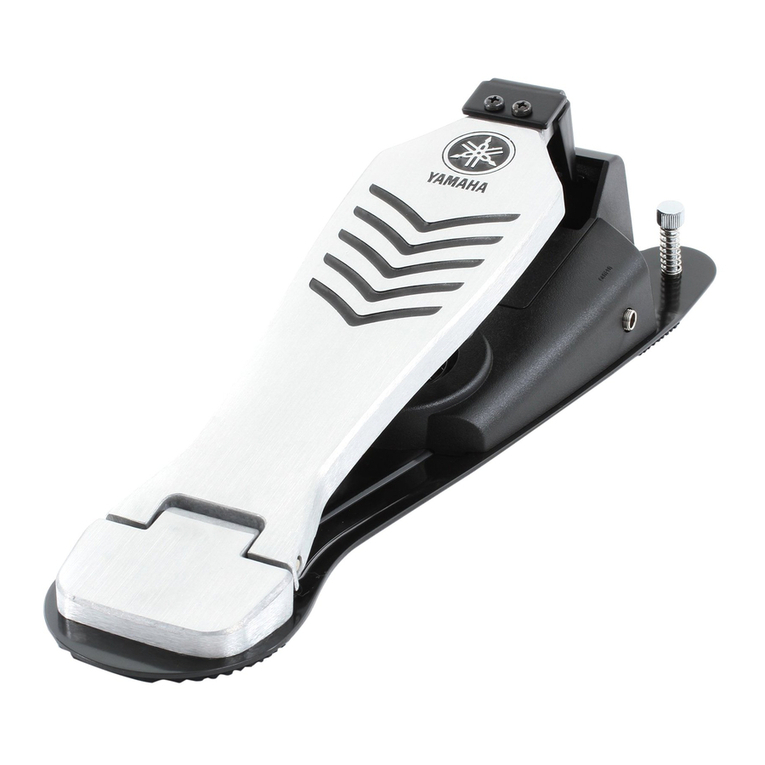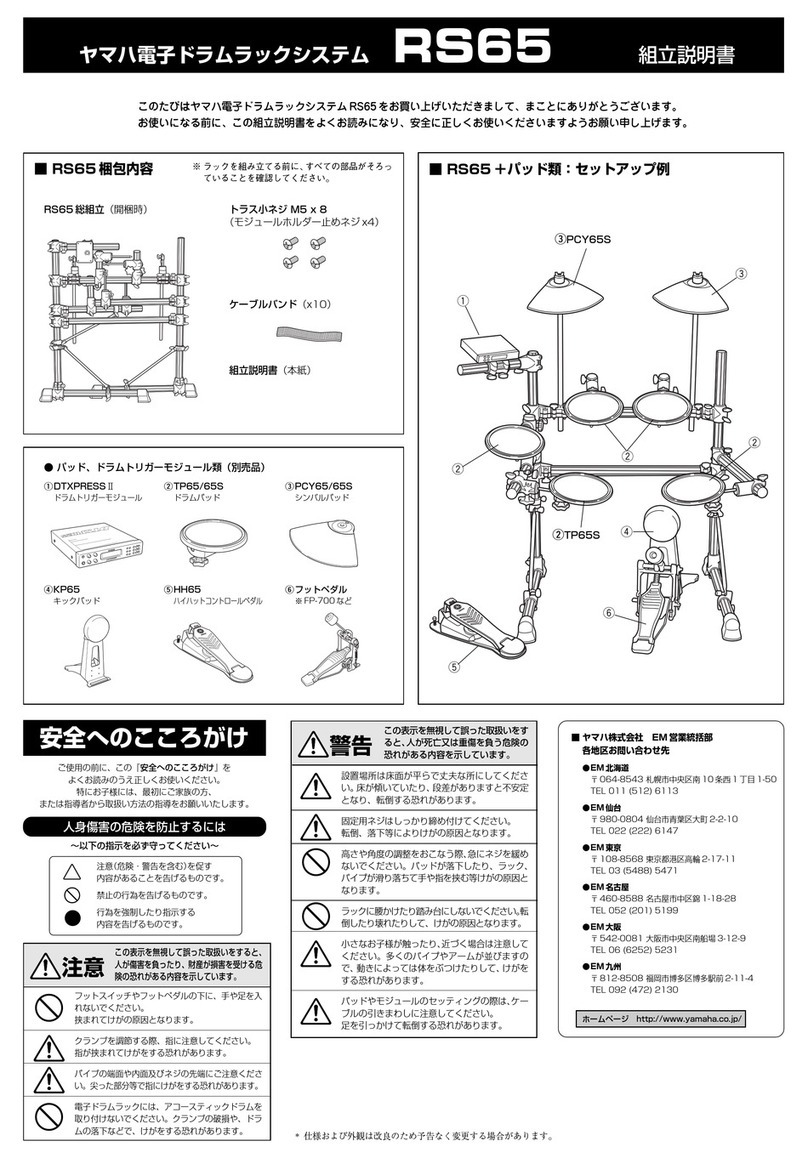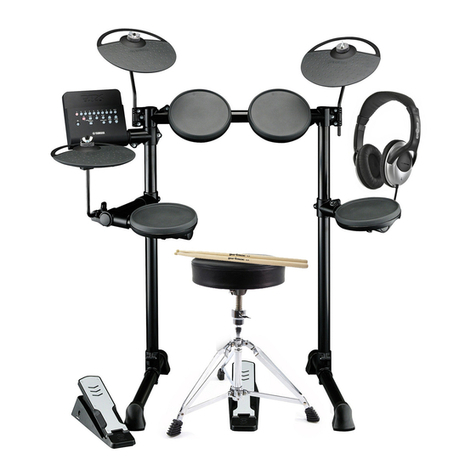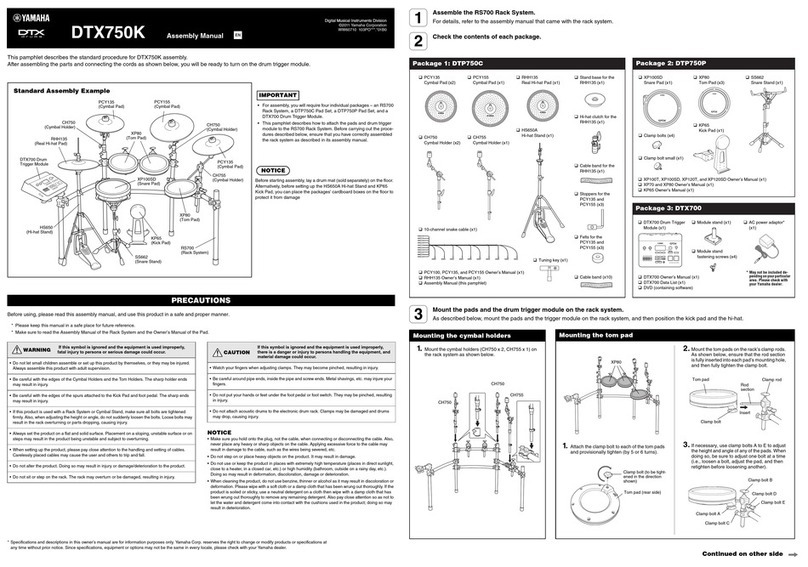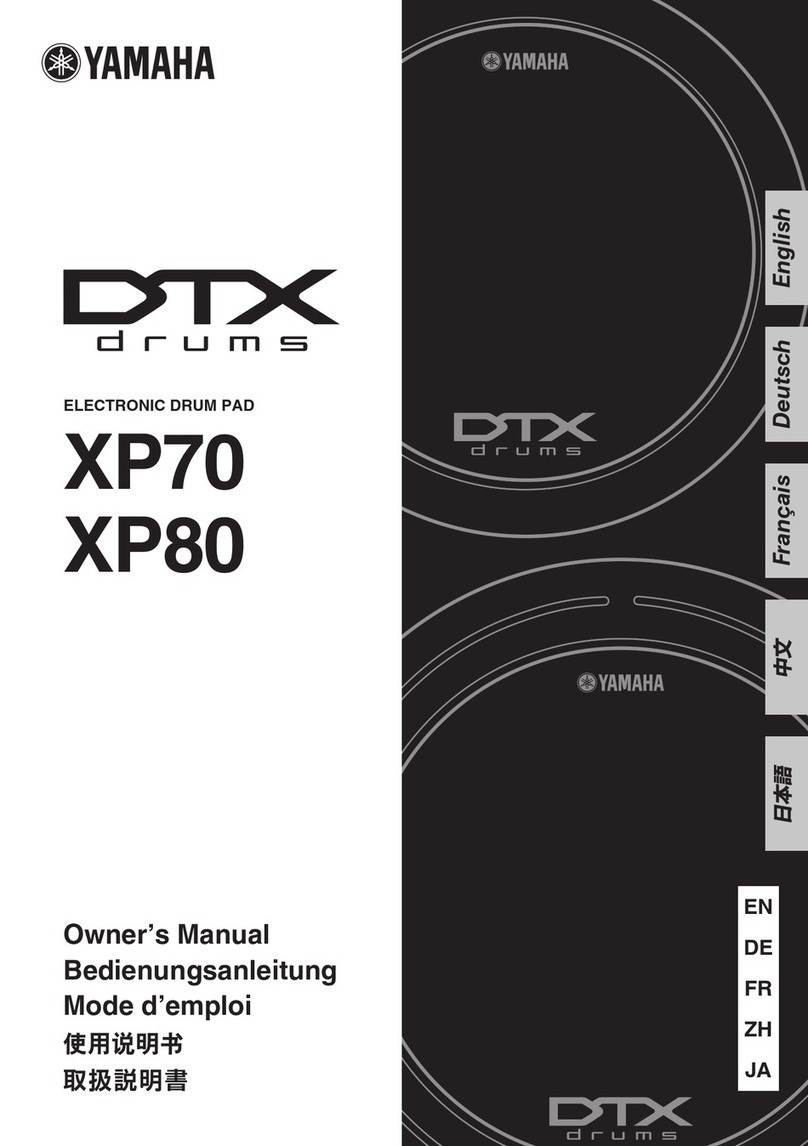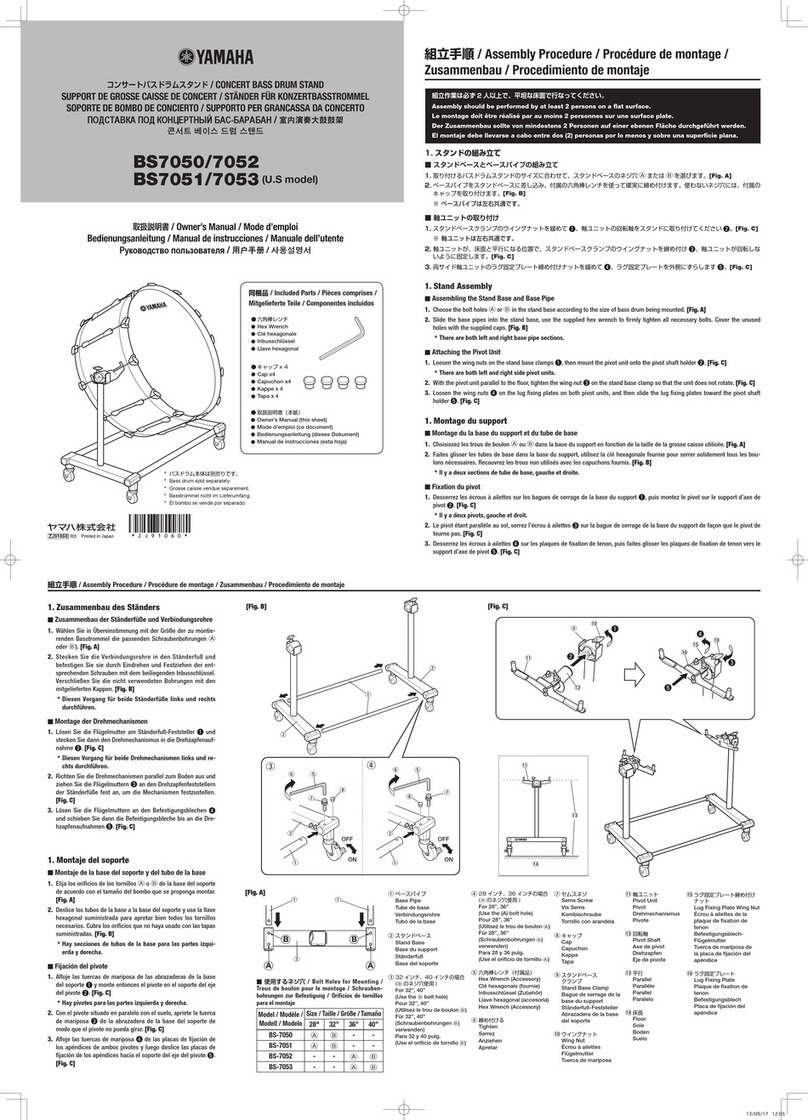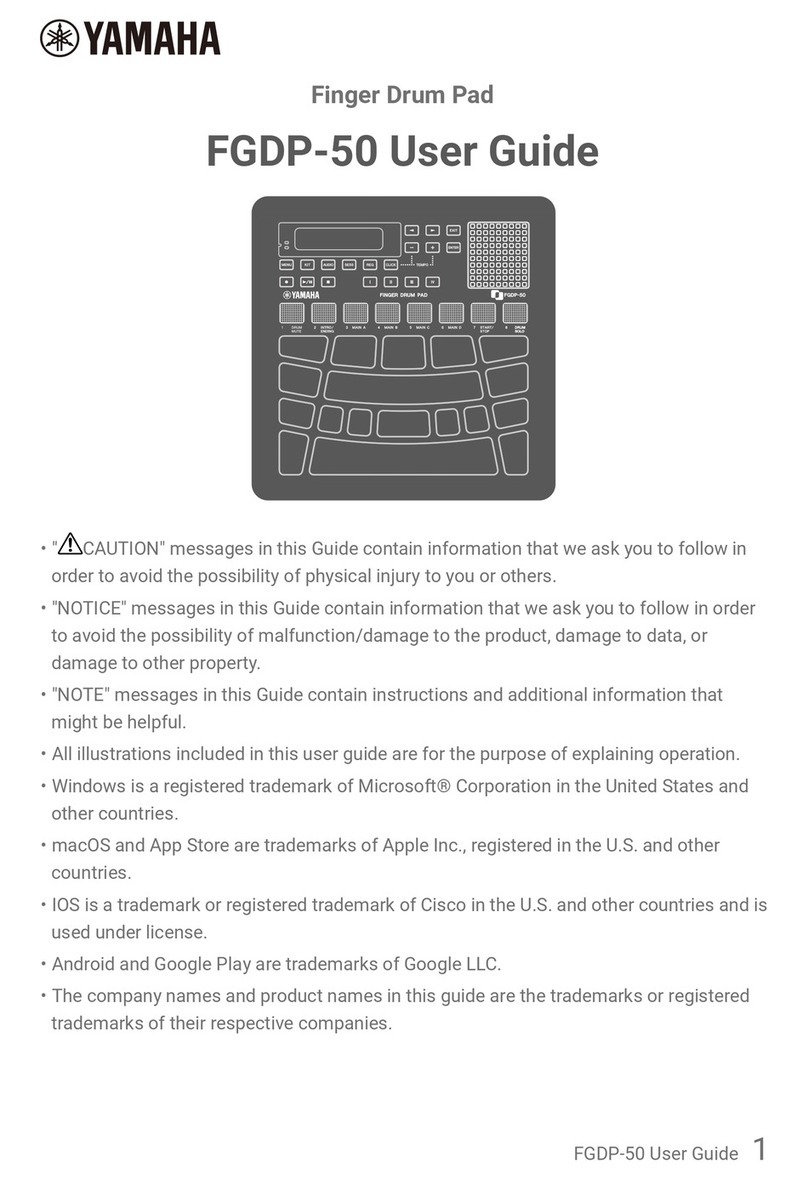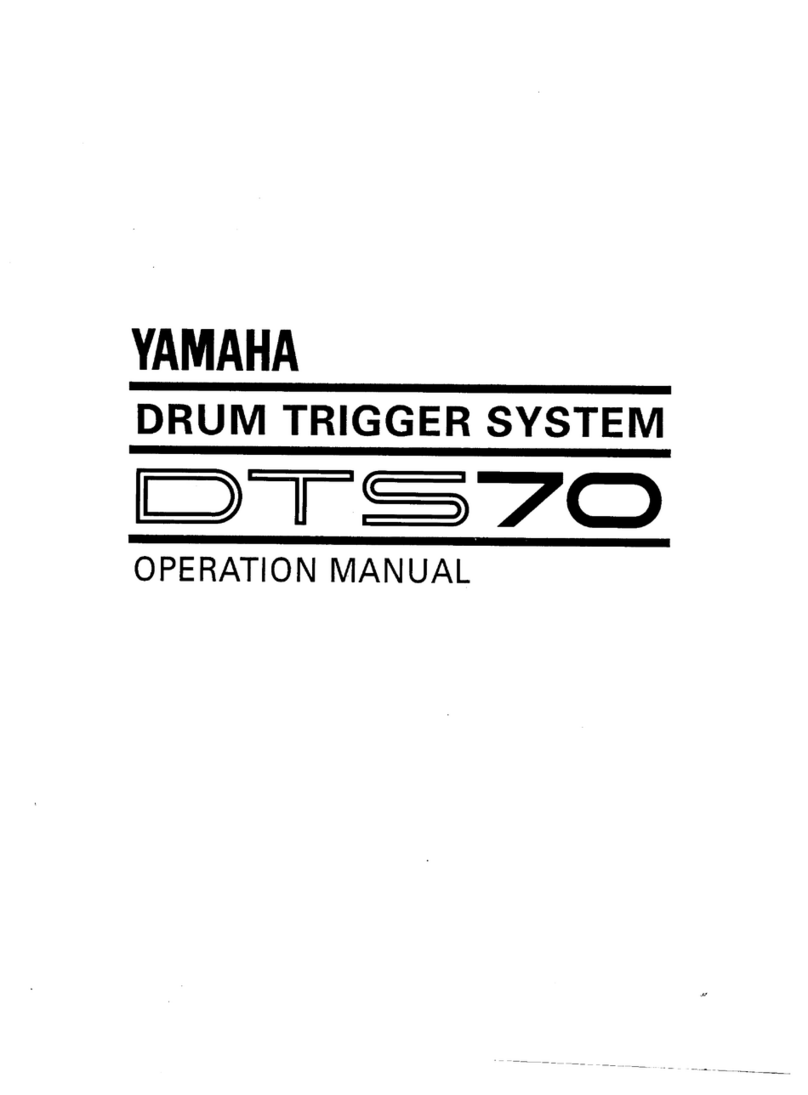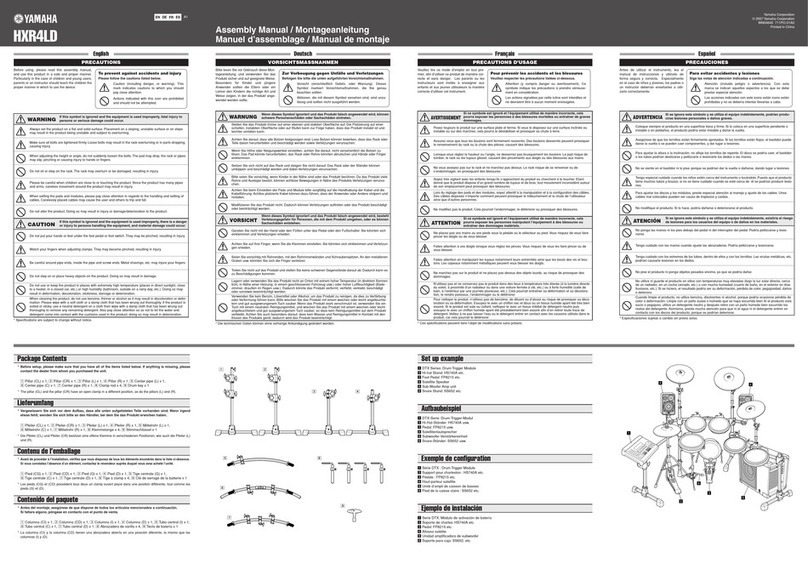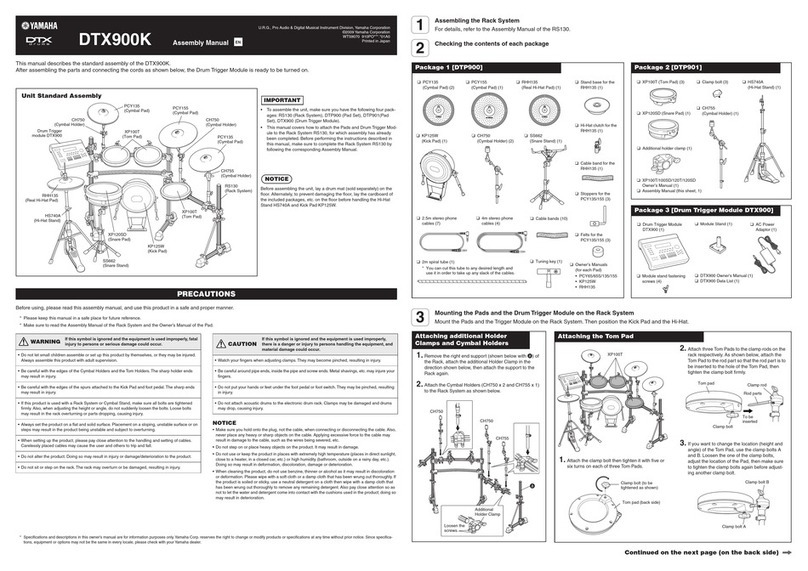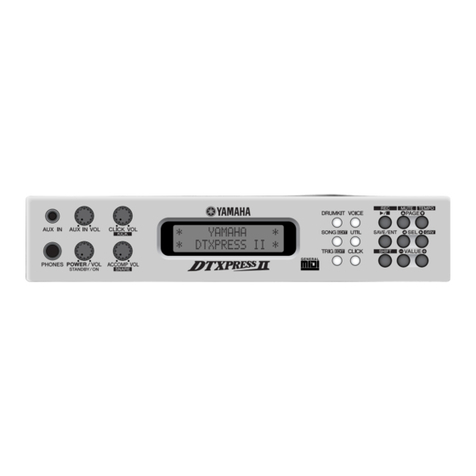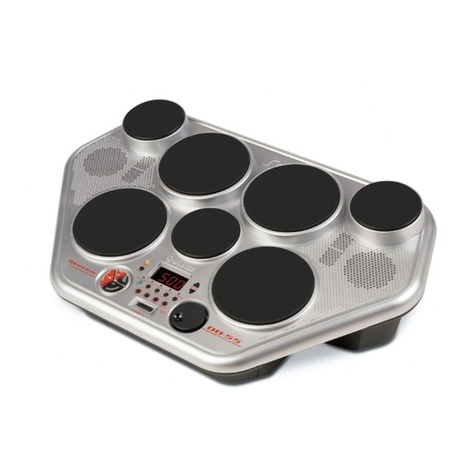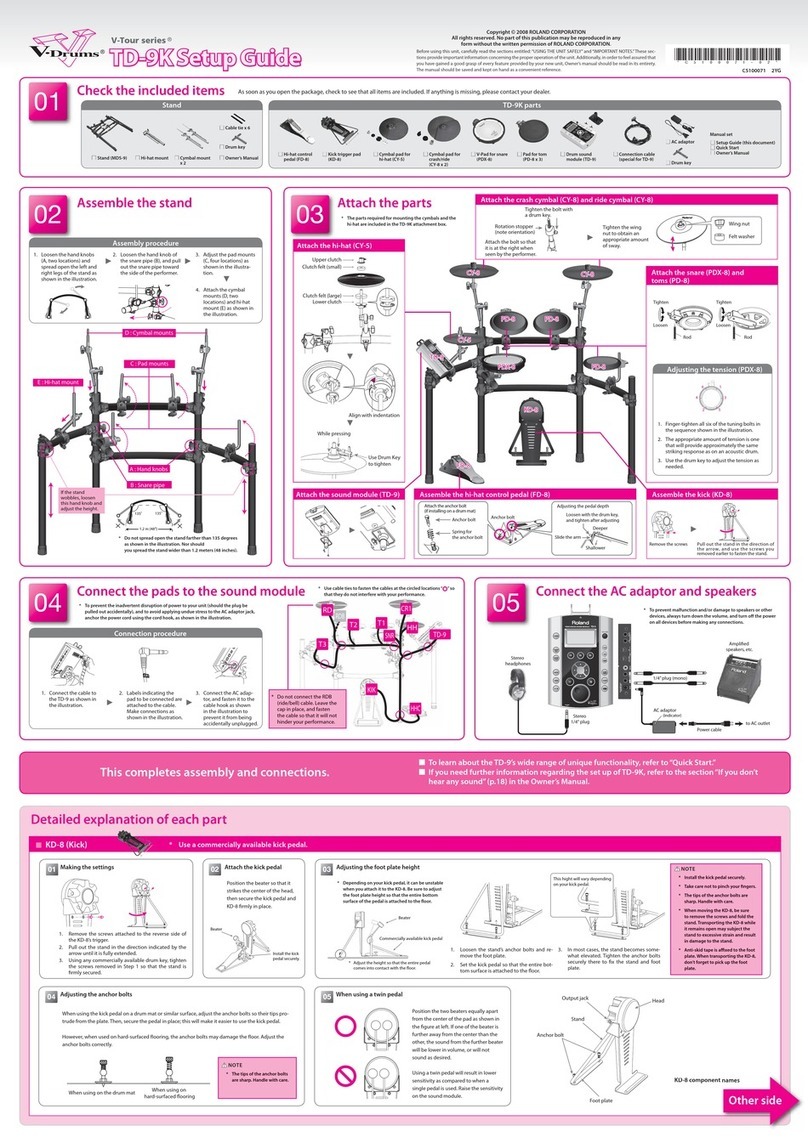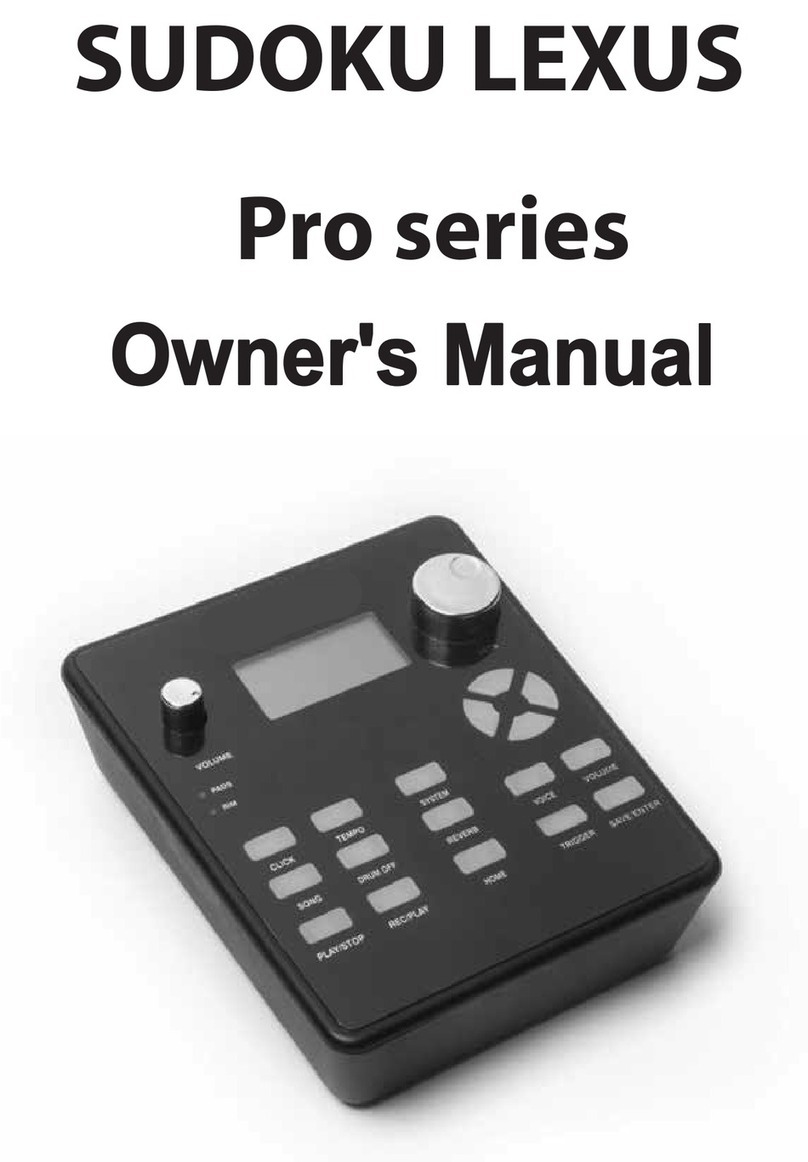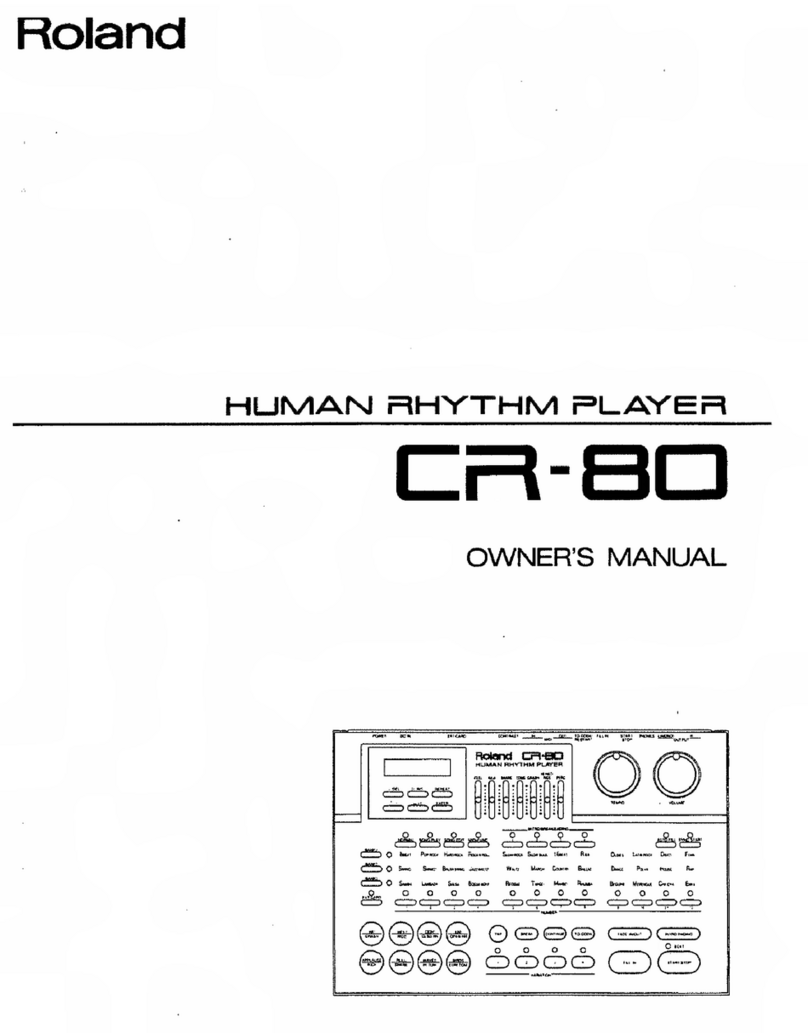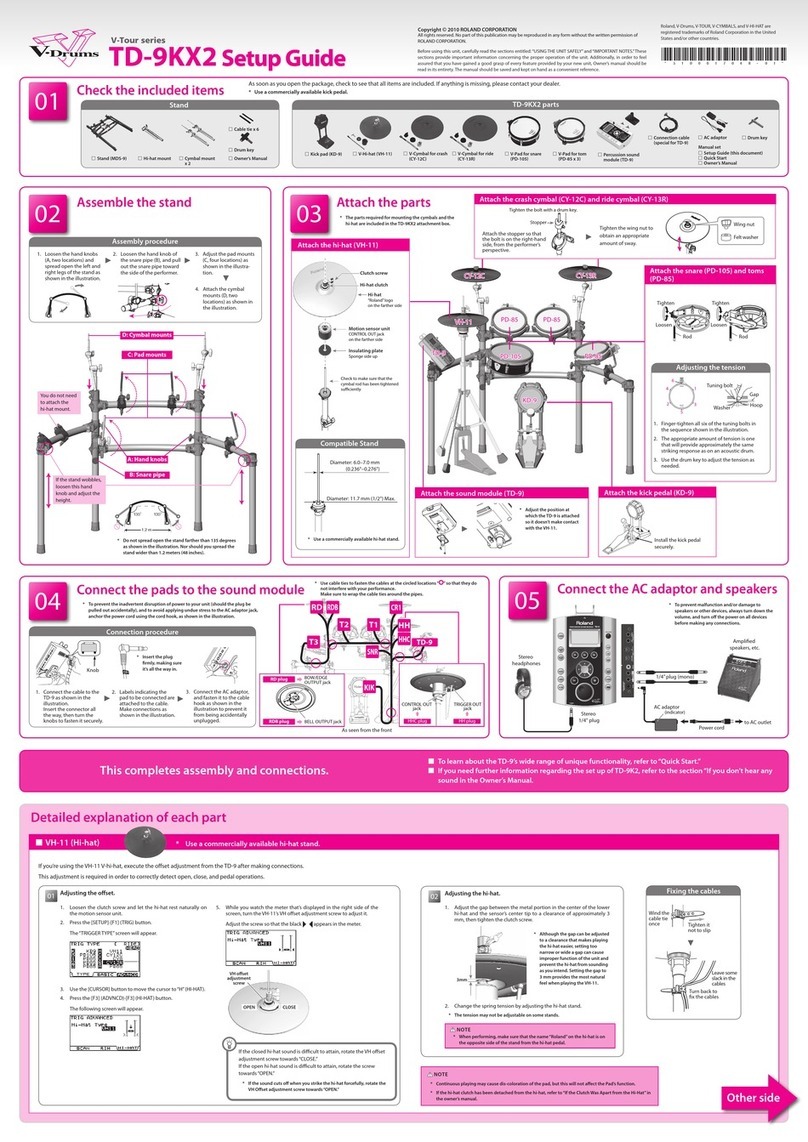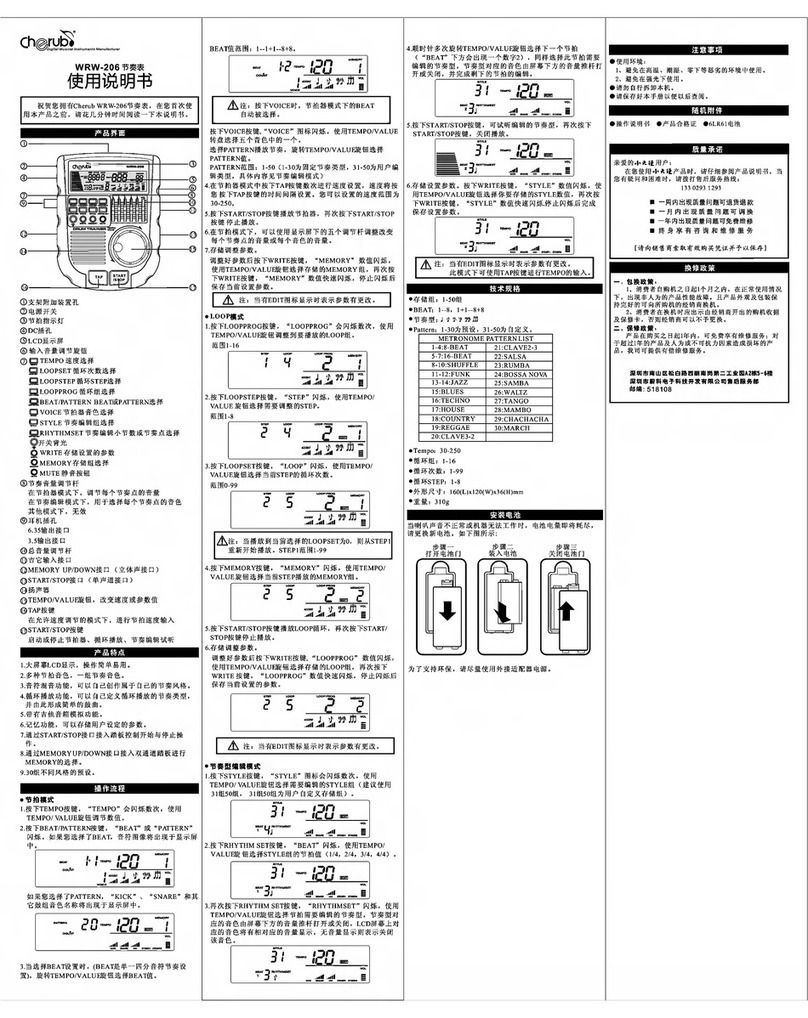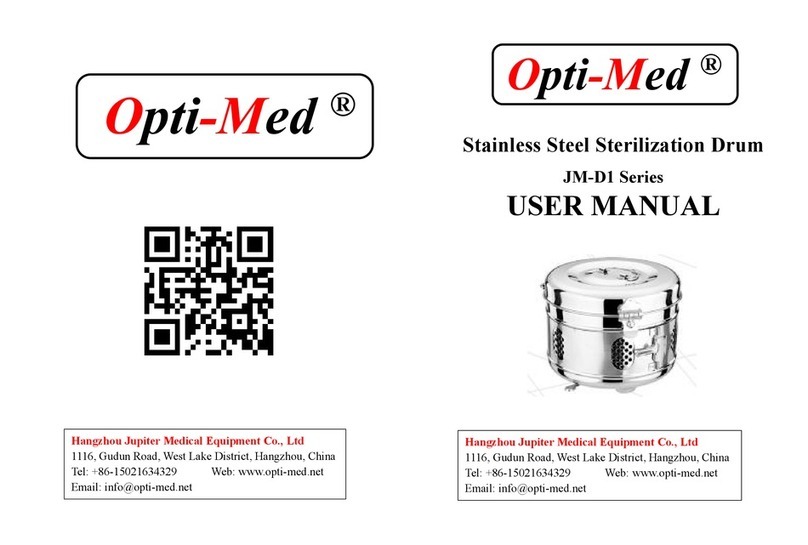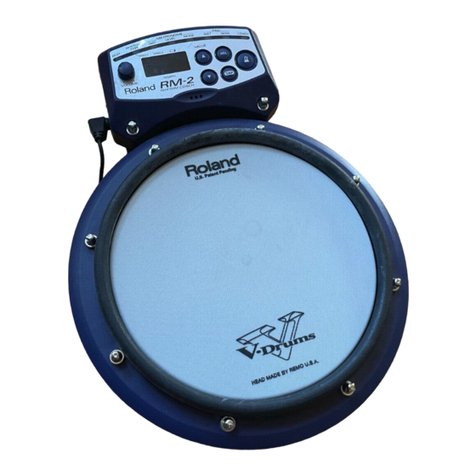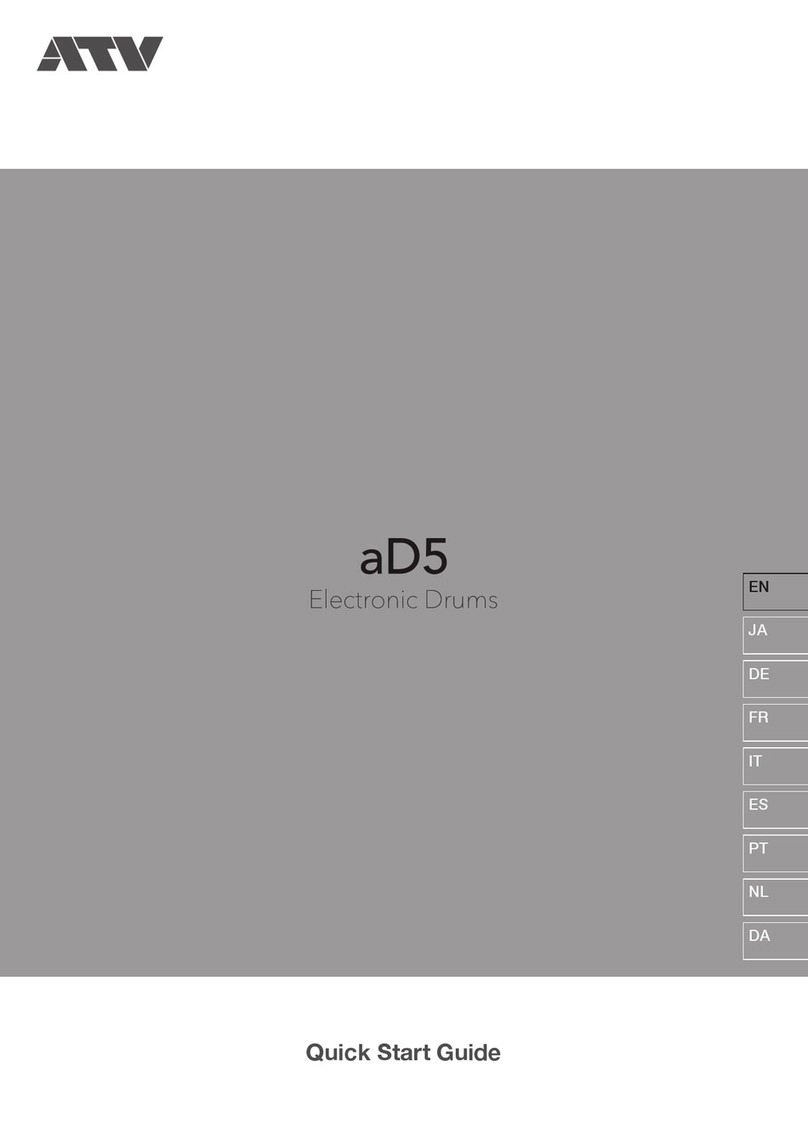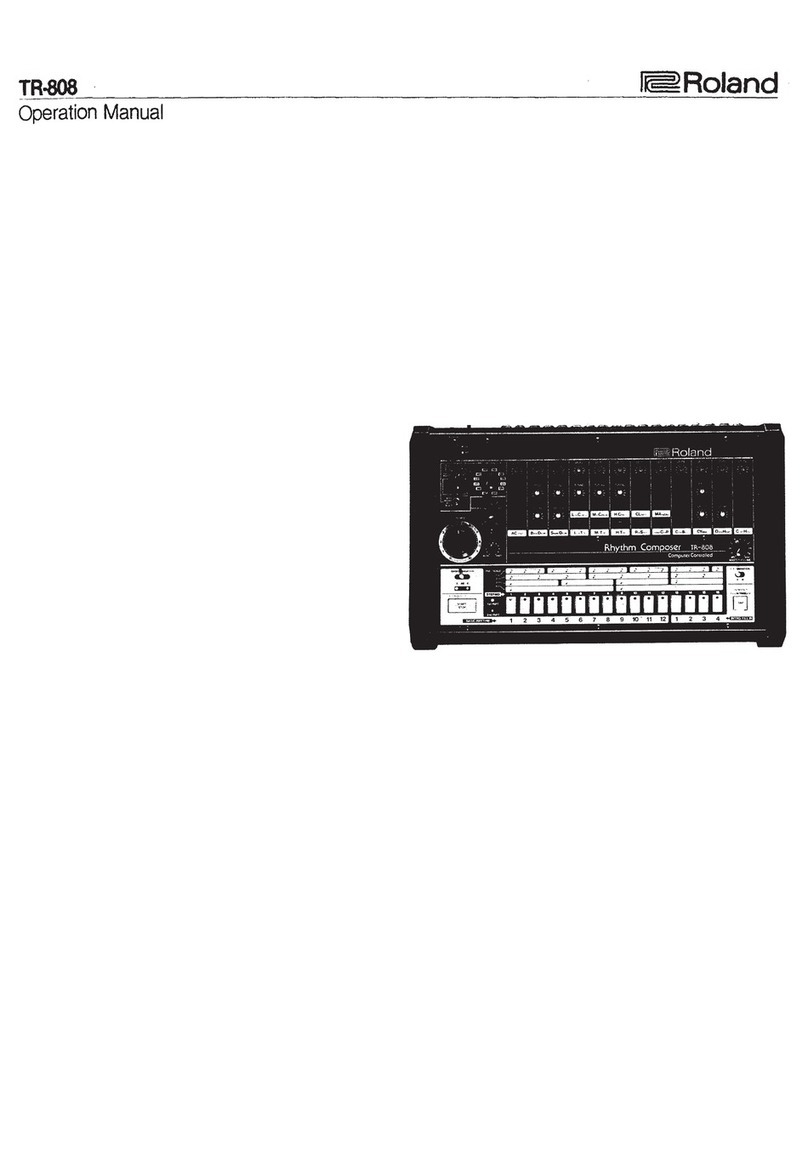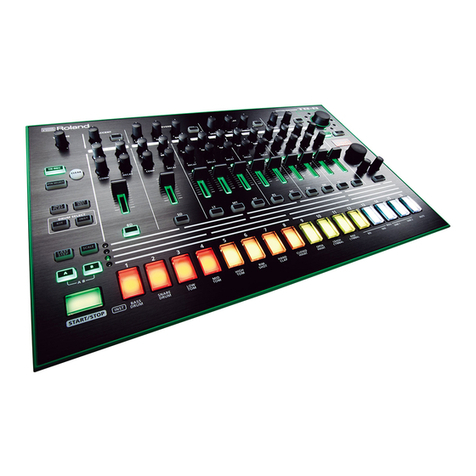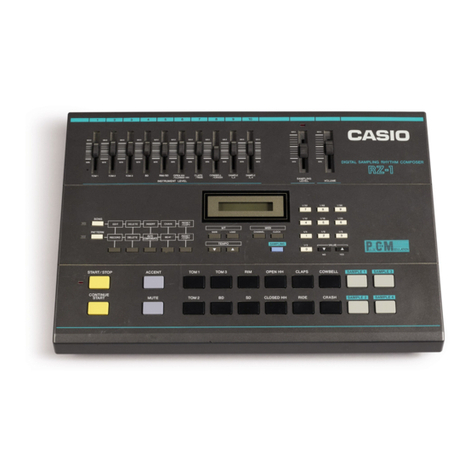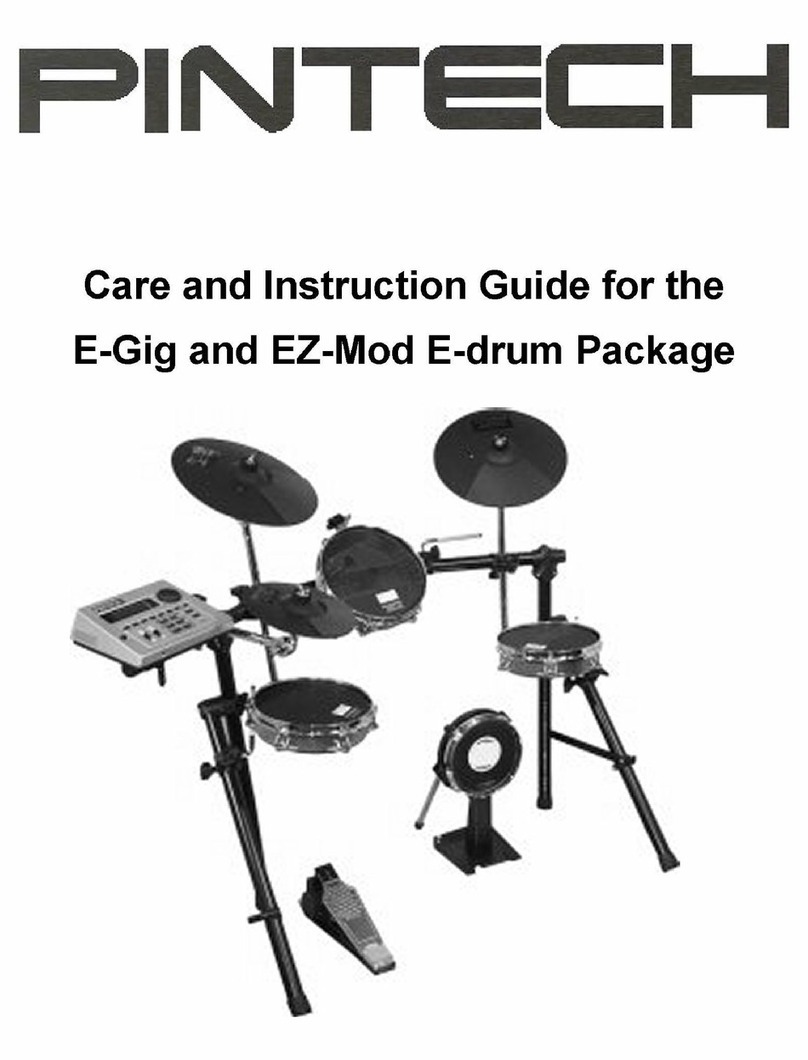
Special Set V2 Assembly Manual
This manual describes the standard assembly of the DTXPRESS IV Special Set V2.
After assembling the parts and connecting the cords as shown in Figure 1, the
unit is ready to be turned on.
* To assemble the unit, make sure you have the following three packages:
- RS85 (Rack System)
- DTP4K2SP (Pad Set)
- DTXP4 (Trigger Module)
Before assembling the unit, lay a drum mat (sold separately).
Before assembling the unit, lay a drum mat on the oor. Alternately, to prevent
damaging your oor, lay the cardboard of the included packages, etc. on the
oor before assembling the two parts shown in the circles in Figure 1.
Figure 1: Unit Standard Assembly
qDTXP4 (Drum Trigger Module)
wRHH135 (Real Hi-Hat Pad)
eTP100 (3-zone Drum Pad)
rHS650A (Hi-Hat Stand)
tAC Adaptor
yPCY135 (3-zone Cymbal Pad)
uPCY155 (3-zone Cymbal Pad)
iTP65 (Drum Pad)
oKP65 (Kick Pad)
!0 RS85 (Rack System)
Checking the contents of RS85
Open the RS85 (Rack System) package and conrm the contents.
Figure 2: RS85 (Rack System)
RS85 (1) Rubber Foot (2)
Cable Band (6) *1
Assembly Manual (1) *2
- RS85
*1 Use cable bands to bind cables to pipes in “ Connecting to a power source”. (Spare bands are included.)
*2 Not this manual.
Assembling the Rack System
1Take out the rack system from the package and remove all the cushioning. Remove the
bubble wrap on the pipes while assembling the rack system.
The pipe ends may injure your ngers.
Figure 3: Rack Assembly-1
*1 YAMAHA logo label on the red curved pipe is facing the opposite side.
*2 e knob is on the opposite side of the pipe.
Figure 4: Rack Assembly-2
2See Figure 3. Set up the rack system, with the YAMAHA logo label (a) on the red curved
pipe facing the opposite side from you. Support the rack system with your left hand, and
loosen the two knobs (b) and (c) on your right.
3See Figure 4. Move the leg on your right (pipe ) in a counterclockwise direction until it is
about 90 degrees from the red curved pipe with the YAMAHA logo label. Tighten the two
knobs loosened in step 2 and x the position of pipe .
4See Figure 3 again. Loosen the two knobs (d) and (e) on your left. The knob (d) is on the
opposite side of the pipe.
5See Figure 4 again. Move the leg on your left (pipe ) all the way around the standing
vertical pipe in a counterclockwise direction until it is parallel with pipe . Tighten the two
knobs loosened and x the position of pipe .
Be sure to move pipe in a counterclockwise direction. If you move it in
a clockwise direction, the slim pipes may collide and bend.
* In the following steps, loosen the knobs rst, decide the position of the pipe, and then
tighten the knobs. Be careful not to tighten the knobs excessively. For better perfor-
mance, make minor adjustments for each part of the unit with the knobs after the as-
sembly is completed.
Figure 5: Rack Assembly-3
6See Figure 5. Loosen the three knobs of pipe , which are on the left bottom and opposite
side from you (shown with ). Hold the area of pipe and shown with , and slide
pipe so the further end of pipe will slide outward about 7 cm from the joint part with
the standing vertical pipe. In the same manner, loosen the three knobs of pipe ,
which are on the right bottom and opposite side from you. Slide pipe so the further end
of pipe will slide outward about 7 cm from the joint part with the standing vertical pipe.
Tighten the six knobs loosened and x the position of pipes and .
7Insert the rubber foot on each further end of pipe and .
Figure 6: Rack Assembly-4
8See Figure 6. Loosen the two knobs ((h) on the upper left) aligned at the base of pipe
, and move pipe slightly outward in a clockwise direction. Tighten the two knobs
loosened and x the position of pipe .
9Loosen the two knobs ((j) on the middle right) aligned at the base of pipe and the
knob ((k) on the lower right) of the slim pipe supporting pipe . Move pipe in a
counterclockwise direction until it is about 90 degrees from the red curved pipe with the
YAMAHA logo label. Tighten the three knobs loosened and x the position of pipe and
the slim pipe supporting it.
10 Loosen the two knobs ((m) on the middle left) aligned at the base of pipe and the knob
((n) on the lower left) on the slim pipe supporting pipe , and move pipe in a clockwise
direction until it is about 45 degrees from the red curved pipe with the YAMAHA logo
label. Tighten the three knobs loosened and x the position of pipe and the slim pipe
supporting it.
The pipes may bend when the area shown in collides.
11 Check that the entire rack system is stable. Hold the upper area of the vertical pipe and
, and shake them. If the rack system is unstable, retighten the knobs tightened in steps 2
to 5.
PRECAUTIONS
Before using, please read this assembly manual, and use this product in a safe
and proper manner. Particularly in the case of children and young users, parents
or an instructor should teach the children the proper manner in which to use the
device.
WARNING
If this symbol is ignored and the equipment is used
improperly, fatal injury to persons or serious damage could
occur.
Do not let small children assemble or set up this product by themselves, or they may
be injured. Always assemble this product with adult supervision.
Be careful with the edges of the cymbal holders and the tom holders.The sharp holder
ends may result in injury.
Be careful with the edges of the spurs attached to the base. The sharp spur ends may
result in injury.
If this product is used with the rack system or a cymbal stand, make sure all bolts are
tightened firmly. Also, when adjusting the height or angle, do not suddenly loosen
the bolts. Loose bolts may result in the rack overturning or parts dropping, causing
injury.
Always set the product on a flat and solid surface. Placement on a sloping, unstable
surface or on steps may result in the product being unstable and subject to
overturning.
When setting the product, please pay close attention to the handling and setting of
cables. Carelessly placed cables may cause the user and others to trip and fall.
Do not alter the product. Doing so may result in injury or damage/deterioration to the
product.
Do not sit or step on the rack. The rack may overturn or be damaged, resulting in
injury.
Figure 7: Rack Assembly-5
12 See Figure 7. Loosen the knobs of the cymbal holders , and on the right and left
(shown with on the opposite side of pipe and ) and pull up the cymbal holders
vertically to the height illustrated. Tighten the knobs loosened and x the positions of the
cymbal holders.
13 Loosen the wing bolt (p) of the cymbal holder and set up the upper part of the cymbal
holder. Tighten the wing bolt loosened and x the position of the cymbal holder . Set up
the upper part of the cymbal holders and in the same manner.
14 Loosen the two knobs (q) aligned along the pipe with the Trigger Module attachment part
.
Adjust the Trigger Module attachment part so the operating panel will face upward
diagonally to your side when set. Hold the Trigger Module attachment part rmly and
turn it gradually. Tighten the two knobs loosened and x the position of the Trigger Module
attachment part .
Checking the contents of the Pad Set and the
Trigger Module
Open the DTP4K2SP (Pad Set) and Trigger Module package and conrm the
contents.
Figure 8: Pad Set DTP4K2SP
TP65 (Drum Pad) (3)
TP100 (3-zone Drum Pad)
(1) Clamp Bolt (4)
PCY135 (Cymbal Pad) (2) PCY155 (Cymbal Pad) (1) Felt (Large) (3)
Stopper (3)
RHH135
(Real Hi-Hat Pad) (1)
Hi-Hat Clutch (1) Stand Base (1)
Stereo Phone Cable (1) Cable Band (1)
HS650A (Hi-Hat Stand) (1)
KP65 (Kick Pad) (1) Drum Key (1)
9-channel snake cable (1)
Instruction Manual (4)
- TP65/65S/100/120SD
- PCY65/65S/135/155
- KP65
- RHH135
Figure 9: Trigger Module
DTXP4 (1) Wing Bolt (2)
Module Stand (1)
AC Adaptor
CAUTION
If this symbol is ignored and the equipment is used
improperly, there is a danger or injury to persons handling
the equipment, and material damage could occur.
Watch your fingers when adjusting clamps. They may become pinched, resulting in
injury.
Make sure you hold onto the plug, not the cable, when connecting or disconnecting
the cable. Also, never place any heavy or sharp objects on the cable. Applying
excessive force to the cable may result in damage to the cable, such as the wires being
severed, etc.
Do not step on or place heavy objects on the product. It may result in damage.
Be careful around pipe ends, inside the pipe and screw ends. Metal shavings, etc. may
injure your fingers.
Do not put your hands or feet under the foot pedal or foot switch. They may be
pinched, resulting in injury.
Do not use or keep the product in places with extremely high temperature (places in
direct sunlight, close to a heater, in a closed car, etc.) or high humidity (bathroom,
outside on a rainy day, etc.). Doing so may result in deformation, discoloration,
damage or deterioration.
When cleaning the product, do not use benzine, thinner or alcohol as it may result in
discoloration or deformation. Please wipe with a soft cloth or a damp cloth that has
been wrung out thoroughly. If the product is soiled or sticky, use a neutral detergent
on a cloth then wipe with a damp cloth that has been wrung out thoroughly to
remove any remaining detergent. Also pay close attention so as not to let the water
and detergent come into contact with the cushions used in the product; doing so
may result in deterioration.
Do not attach acoustic drums to the electronic drum rack. Clamps may be damaged
and drums may drop, causing injury.
Continued on the next page (on the back side)
DTXPRESSSP-seten0407.indd1DTXPRESSSP-seten0407.indd1 2009/04/0710:56:282009/04/0710:56:28
